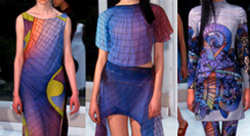Japanese Fashion Designer Eri Matsui Puts Mathematica on the Tokyo Catwalks
When the 2000 Fall and Winter Tokyo Collection was presented in April, the unique Mathematica-inspired designs therein captured the attention of the fashion world. Japanese fashion designer Eri Matsui, who searches for forms of beauty through her work, used Mathematica to create these clothing patterns ranging from the utterly simplistic to the incredibly intricate.
The Eri Matsui collection included designs of mathematical forms such as Klein bottles, Escher patterns and knot theory, the latter of which she says "approaches a single solution in a mathematical sense while creating many variations in a fashion sense." And although computers were used for the creation of the designs, they reminded many viewers of biological things, much like the traditional beauty of the Japanese kimono.
This response to her work supports Ms. Matsui's belief in an embracive, not contrasting, relationship between computers and nature, science and art. Her search for universal forms to make women look beautiful initially led Ms. Matsui to explore the golden ratio. When she began to think about "What is beauty?" from a mathematical point of view, her interest grew to encompass the entire geometrical science. She first saw examples of Mathematica being used to create such stunning graphics in the Newton Magazine.
Ms. Matsui began her career as a fashion designer in Chicago, Illinois, after her husband was transferred abroad. She had previously studied fine arts and craft design in high school and college, working as a graphic designer for a time. While in Chicago, she attended William Rainey Harper College, where she was exposed to fashion design for the first time and found it suited her perfectly. After six years in Chicago, and numerous awards, she returned home and established "Eri Matsui Japan," now with studios in Tokyo and Paris.
Ms. Matsui has been unveiling her fashions in the Tokyo Collection Shows for over a decade now, as her reputation has grown. Following the show, a representative from a Japanese Mathematica reseller gave a demonstration of how Mathematica was used in the design process of this year's collection. Ms. Matsui says she uses Mathematica because "I can compare between things generated from a computer and things created with human passions.... I cannot tell what I am going to get when providing different conditions and rules; however, this anticipation makes it more exciting for me." Once a design has been created in Mathematica, she uses a transcribing technique to transfer it to the material.
The collection was extremely popular amongst viewers at the show, and Ms. Matsui has already sold the "Knot Theory" designs to an international buyer. In July, Hikaru Nishida, a famous Japanese singer, performed live on a prestigious Japanese public television station wearing one of Ms. Matsui's Mathematica-inspired designs. Due to extensive media interest, a formal interview with Ms. Matsui was also conducted and an article about her and her use of mathematics in her work recently appeared in several Japanese publications.
Mathematica's involvement in the Tokyo Collection has also presented several other opportunities to discuss mathematics with a larger audience. For example, Ms. Matsui has been invited to lecture at Musashino Art University, where she herself was once a student, on the relationship and boundaries between the arts and sciences. Ms. Matsui, who acknowledges that nowadays many people are not interested in mathematics, points to the fact that, "I didn't like it either {laugh}. I never thought it could be such a beautiful and lovely thing!"
Get started with Wolfram technologies, or work with us to apply computational expertise to your projects.
Questions? Comments? Get in touch: 1-800-WOLFRAM, or email us »









